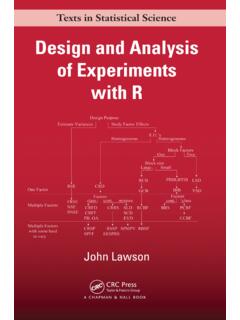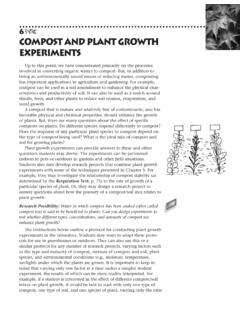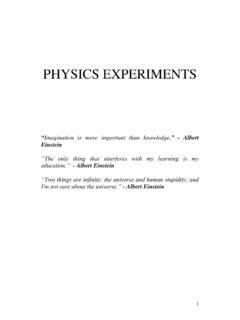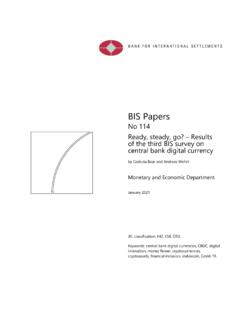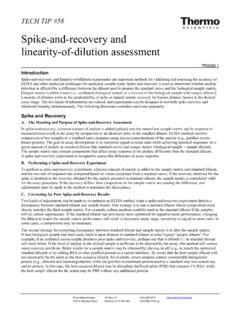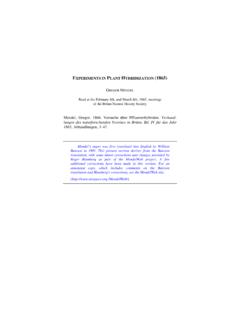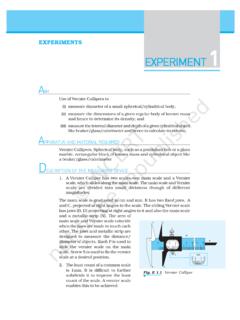Transcription of Pipe Flow Experiments - Warwick
1 -1- Pipe Flow Experiments Group: _____ Day: _____ Week: _____ Library Card Number of Your Group Members -2- University of Warwick School of Engineering ES2A7 laboratory Exercises Section I Theoretical Preparation 1. Introduction In this experiment you will investigate the frictional forces inherent in laminar and turbulent pipe flow. By measuring the pressure drop and flow rate through a pipe, an estimate of the coefficient of friction (friction factor) will be obtained. Two different flow situations will be studied, laminar flow and turbulent flow. The experimentally obtained values of the coefficient of friction will then be compared with established results by plotting them on the Moody chart provided. 2. Preparation for laboratory class It is essential that you have a qualitative understanding of the structure of the flow through a circular pipe.
2 Below is a list of references to pages in the lecture notes of ES2A7 (Technological Science 2) as well as references to appropriate chapters in text books which you should consult before attending today s laboratory. The key topics to recall or to familiarise yourself with are: z Laminar pipe flow z Turbulent pipe flow z Velocity profile z Volumetric flow rate and mean flow speed z Coefficient of friction z Poiseuille flow z Effect of surface roughness z Moody Chart Essential reading for your laboratory course is provided in the computer program, appropriate handouts, the recommended course textbook and your lecture notes. The topics are covered in the following text book in the chapter indicated. Suggested reading z White, F. M. 2003, Fluid Mechanics, 5th Edition, McGraw-Hill, Chapter 6; z Roberson J.
3 A., Crowe, C. T., Engineering Fluid Mechanics, 6th Edition, John Wiley&Sons, Chapter 10; z Shames, I. H., Mechanics of Fluids, 3rd Edition, McGraw-Hill, Chapter 9; -3- z Munson B. R., Young D. F., Okiishi, T. H., Fundamentals of Fluid Mechanics, 4th Edition, John Wiley&Sons, Chapter 8; z Tritton, D. J. 1988, Physical Fluid Dynamics, 2nd Edition, Oxford Publications, Clarendon Press, Chapter 6. z Books on fluid mechanics in the library look for sections on pipe flow in any fluid dynamics text book. 3. Background Turbulent flow and laminar flow, Reynolds number Figure 1 shows the three regimes of viscous flow. The changeover from laminar flow to turbulent flow is called transition. Transition depends upon many effects, , wall roughness or fluctuations in the inlet stream, but the primary parameter is the Reynolds number.
4 Reynolds number is the ratio of inertial forces (U ) to viscous forces (L ) and is used for determining whether a flow will be laminar or turbulent: ReUL = (1) Where is the density of the fluid, U is the nominal velocity, L is the characteristic length, and is the dynamic viscosity of the fluid. Figure 1. The three regimes of viscous flow: (a) laminar flow at low Re; (b) transition at intermediate Re; (c) turbulent flow at high Re. Since the velocity profiles of laminar flow and turbulent flow are different (see Figure 2), the nominal velocities used here are the mean velocities of the flows: 22 UAtdt == VV (2) where V is the measured flowing fluid volume over a period of time t, and A is the area of the cross section. Alternatively, given fluid mass M: -4- 22 UAtdt == MM (3) Figure 2.
5 Velocity Profiles Example 1 The accepted transition Reynolds number for flow in a circular pipe is ,Re2, 300dcUd = . For flow through a pipe, at what velocity will this occur at 20CD for: (a) oil flow (3861oilkg m =, m =) with diameter of 19mm; (b) water flow (3998waterkg m =, m =) with diameter of 17mm? Solution (a) ,Re2300 oiloilUd === (b) ,Re2300 waterwaterUd === Friction coefficients of pipe flow -5- Figure 3. Control volume of a steady, fully developed flow between two sections in an inclined pipe. Consider fully developed flow through a constant-area pipe between section 1 and 2 in Figure 3. The incompressible steady flow energy equation, including friction loss, would generalise to 22,1, 2121222mmfUUppzzhgggg ++= +++ (4) Where fh is the head loss.
6 All terms in equation (4) have dimensions of length {}L. Where ,1mUand ,2mU are the mean flow speeds defined by ,11mUQA= and ,12mUQA= (where 1Q, 2Q are the flow rates at position 1, 2 respectively, and A is the cross-sectional area of the pipe). Since ,1, 2mm mUU U==, equation (4) reduces to ()1212fppphzzzggg = + = + (5) Where p is the pressure drop over length L of pipe. Applying the momentum relation to the control volume in Figure 3, including forces due to pressure, gravity, and shear gives -6- 222wpRgzRRL + = (6) Where R is the radius of the pipe, and we have substituted sinzL = from the geometry of Figure 3. We can see that there is a simple relationship between the shear stress, w at the wall and the pressure gradient down the pipe.
7 Rearranging the above equation gives 4wpLzggd + = (7) Note that this relationship applies equally well to laminar and turbulent flow. By Equations (5) and (7), we find that the head loss is 4wfLhgd = (8) Dimensional analysis shows that the head loss can be represented by 22mfULhfdg= (9) The parameter f is called the Darcy friction factor. The friction factor or coefficient of resistance is a non-dimensional measure of the resistance offered by the wall to flow through the pipe. Finally, the Darcy friction factor can be found using Equations (8) and (9) 28wmfU = (10) For horizontal pipe flow ()0z = 22wRLpR = (11) 2wpRL = (12) From Equation (10) the friction factor f is defined by 2124wmfU = (13) Thus combining Equations (12) and (13) gives -7- 212mpdfUL = (14) Alternatively, the skin friction coefficient can be defined by 212wfmCU = (15) Example 2 An oil with 3900kg m = and m = flows through a pipe as shown in Figure 4.
8 The pressures are known at sections 1 and 2, 10m apart. Given the flow rate by collected in 1mint=, (a) compute the Reynolds number and tell whether the flow is laminar or turbulent, (b) compute the friction coefficient by Equation (14). Figure 4 Solution (a) === V 900 _____ === (b) ()22350000 _____22pdfLU == = Effect of Rough Walls, the Moody Chart Surface roughness also has an effect on friction resistance. It turns out that the effect is negligible for laminar pipe flow, but turbulent flow is strongly affected by roughness. The relations between friction factor, Reynolds number and wall roughness are shown in Moody Chart in Append III. -8- Section II Oil Pipe experiment Calculation 1. Theory Oil pipe:(19dmm=) Figure 5.
9 Schematic of oil pipe rig. Static pressure hole locations: No. Inches mm 1 6 2 12 3 18 4 24 5 30 6 36 7 42 8 48 9 54 10 60 11 72 12 84 13 96
10 14 138 15 168 16 198 17 228 Evaluation of sh Applying the hydrostatic pressure formula to evaluate pressures at points 1 and 2, -9- ()111 2 12 2 12pghpghg hh +=++ , ()()12112 212ppghhhh = + , ()()12 21 12ppghh = , 12 1sppgh = Where ()()12112sghg hh = , ()21211shhh = . If 1 is oil (or water) and 2 is mercury (Hg), then 12oilsppgh = (16) Where ()121 Hgsoilhhh = (17) Roughness Values, in mm 1. Smooth pipes Drawn brass, copper, aluminum, etc. Glass, Plastic, Perspex, Fiber glass, etc. 2. Steel pipes New smooth pipes Centrifugally applied enamels Light rust Heavy brush asphalts, enamels and tars Water mains with general tuberculations 3.










